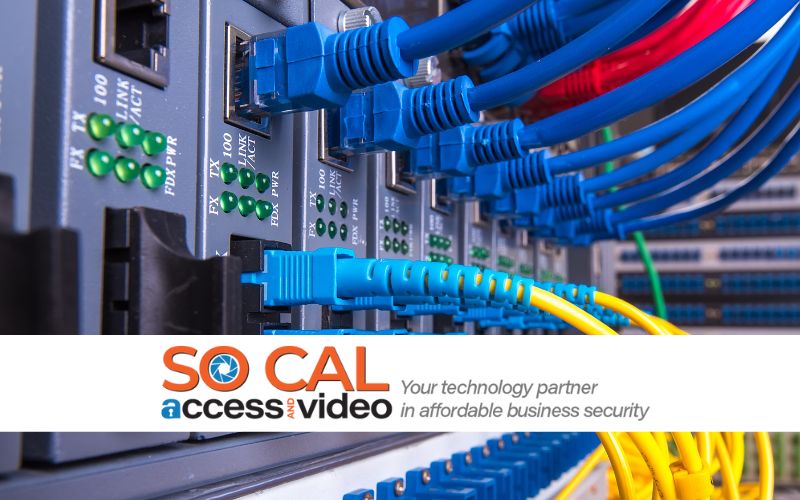When you are building a new commercial security system, one of the first things you will need to consider is video surveillance. The CCTV cameras and data cabling you choose will have a great impact on the capabilities and utility of your system. Here are a few things you should know before purchasing a new CCTV system.
CCTV Cameras Can Offer Many Distinct Features
There are many features to choose from when installing CCTV cameras, so to select the best camera for your business, you need to consider exactly how you will be using it. Are you concerned about people breaking into the building? Are there certain areas inside or outside of the building that you are especially concerned about? This can help you to decide which features you think you’ll need, such as night vision or motion detection.
Design
There are several options for your camera’s design, with a range of shapes and sizes. There are discreet designs such as a bullet camera, which can be mounted on a wall or a ceiling and offers great zoom capabilities. Dome cameras are another discreet option with an orb-shaped covering, which helps to make them less noticeable and more durable than bullet cameras. However, a more visible option such as a turret or PTZ camera can offer a wider range of motion that covers more angles. Ultimately, the decision may come down to the locations and use of the camera.
Analog vs. Digital IP CCTV Systems
Another key decision for your CCTV camera system is whether you will use an analog or digital system. Analog systems are an older technology that have become far less popular in the modern day because they leave a lot to be desired with lower image quality, a lack of internet capability, and no live viewing capacity. Digital systems, on the other hand, offer HD cameras, live viewing, and the ability to use an internet connection for remote viewing. Generally, despite their lower cost, analog systems should only be chosen if you already have an older CCTV system you are looking to update.
Types of Data Cabling
In order to function, your CCTV cameras will need to be plugged in both to power the cameras and, with the exception of Wi-Fi-enabled cameras, to transmit the data. The type of cabling you use will depend a lot on the CCTV camera you choose. An analog CCTV system will more than likely use coaxial or Siamese cables. Coaxial cables are very affordable and have high-quality sheathing that offers a good degree of shielding against interference. Siamese cables are a good option for saving space because they carry both data and power through two separate intertwined internal wires, meaning only one cable is needed. The downside is that these cables can be difficult to handle and are fairly pricey.
For digital IP CCTV systems, there are two options: ethernet or optical fiber. Ethernet cables have a lot of advantages both in terms of price and convenience. Ethernet cables are very affordable, are easy to work with, and can carry power and data. Unfortunately, these cables have the downside of facing a fair degree of video interference between their internal power and data cabling, which limits their effective length.
On the other hand, fiber-optic cables do not carry electricity at all, so a separate power connection will be needed, and they can be costly and difficult to install. However, these cables offer a very high degree of resistance to data loss and can carry significantly more data for superior image quality.
Ultimately, for digital IP CCTV cameras, both ethernet and optic fiber can offer a high degree of quality and utility. The decision between the two will often come down to the camera and storage system you would like to use.
NVR vs. DVR Storage
Regardless of the CCTV cameras and data cabling you choose, you will need to store and access the video footage somehow. This can be done either through a network video recorder (NVR) or a digital video recorder (DVR). For most modern digital IP security systems, NVR is the superior choice. With NVR systems, the storage device and cameras connect to the same IP network and work with mobile devices for remote access and control.
On the other hand, DVRs are generally used with coaxial cables and analog systems. These do not work well with mobile devices and higher-resolution images. Generally, these should only be used when upgrading existing analog systems without replacing the entire existing security system.
Final Thoughts on CCTV Cameras and Data Cabling
Now you know some of the most important details you should keep in mind when purchasing CCTV cameras and data cabling. As you can see, designing and installing a CCTV system can be a difficult task, and it is hard to overestimate the importance of ensuring it is done right—both for optimal security and to avoid unnecessary expenses. The best way to ensure this is to trust the experts like those at SoCal Access and Video to install the right system for your property. Contact SoCal Access and Video today to gain the peace of mind of knowing your property is receiving the protection it needs.

